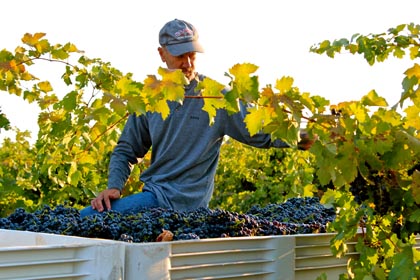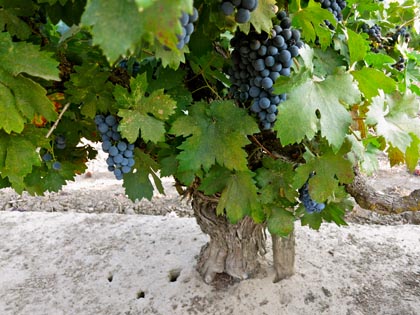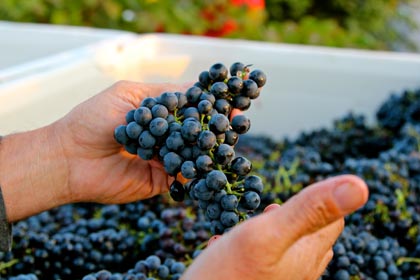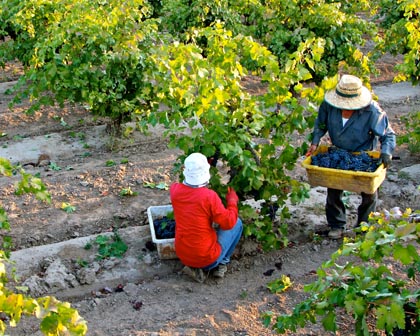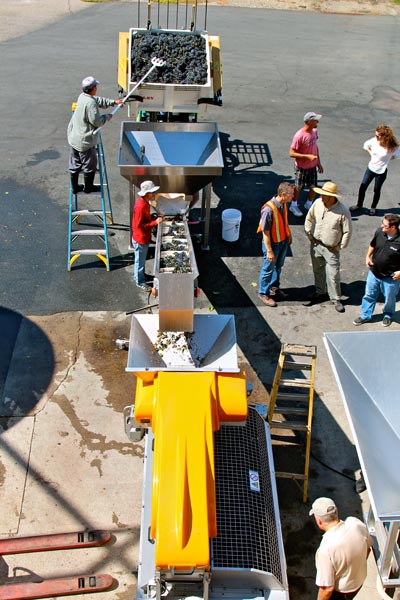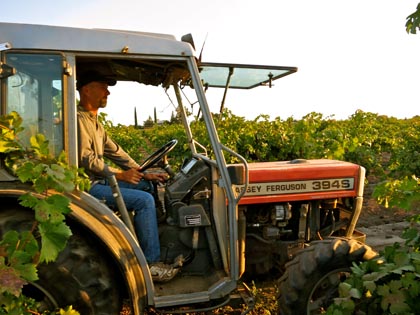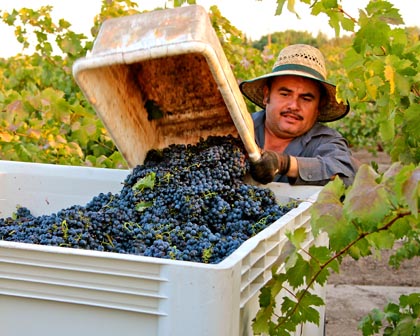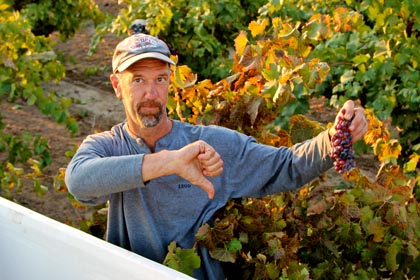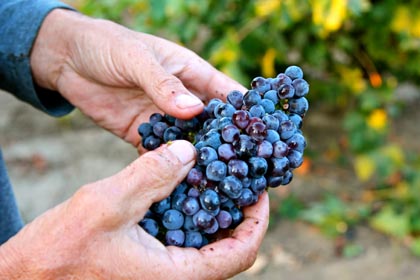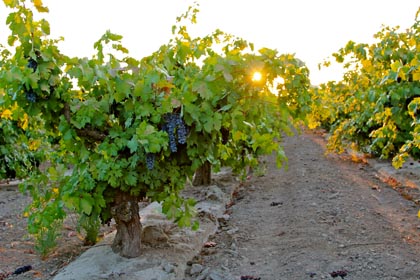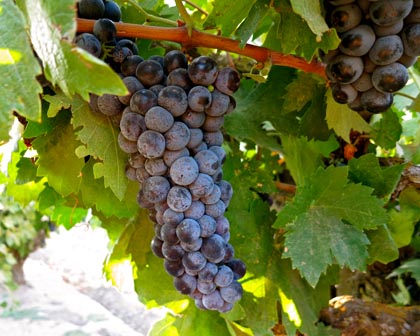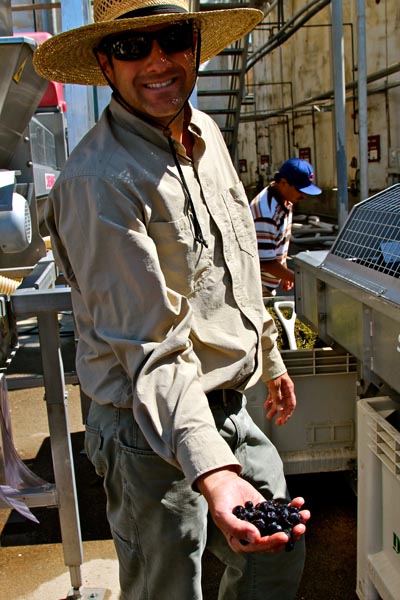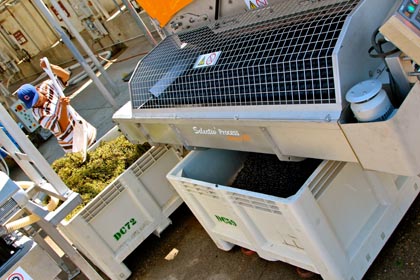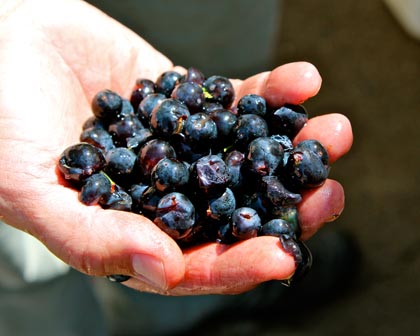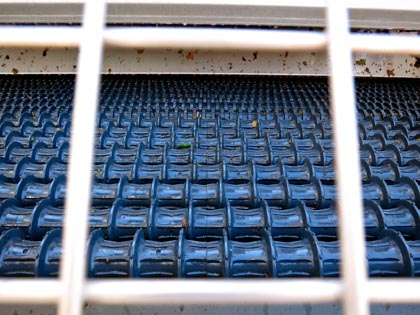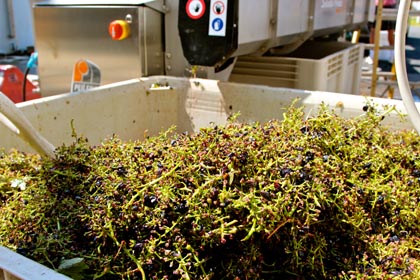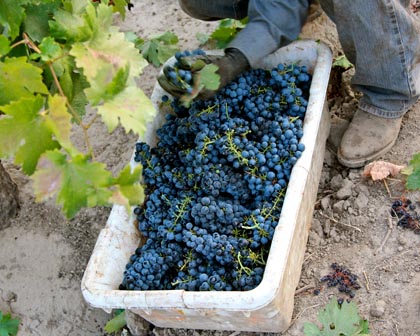Letters from Lodi
An insightful and objective look at viticulture and winemaking from the Lodi
Appellation and the growers and vintners behind these crafts. Told from the
perspective of multi-award winning wine journalist, Randy Caparoso.
Maley harvest harnesses latest technology to produce “pure” Lodi Zinfandel
Through musical vines: Todd Maley sorting Zinfandel in his family’s Weget Vineyard
The Lodi AVA‘s leading winegrowers are no longer shooting just for “varietal” identity in their wines. They are even more focused on producing wines that taste of “Lodi” because, in the end, this is what will set the region apart — not wines that taste like they could come from any other wine region.
At 6 AM yesterday morning (September 10, 2013), Todd Maley was in his family's Weget Vineyard with a crew of 6, doing exactly that: cherry picking the best Zinfandel grapes for his own Maley Brothers label (the "brothers" are Todd's father Joseph Maley, and his uncle Louis Maley), with his eye on an end-product that exemplifies “Maley.”
The Weget block – head trained Zinfandel planted in 1958 on St. George rootstock, on the west side of Lodi’s Mokelumne River AVA – is the heart of the 330 planted acres of wine grapes owned and farmed by the Maleys. Some of it also goes into Macchia's Voluptuous Zinfandel (which well describes the wine), as well as bottlings by m2 and Akin.
55-year old Weget Vineyard Zinfandel vines
Typical of Lodi's longtime growers (the Maleys are descended from Andrew Harshner, who settled in Lodi in 1863 and started a family tree that also includes the Phillips family of Michael David Winery), most of what the Maleys grow goes into the wines by big production wineries. Less than 1% goes into Maley Brothers wines.
Which is why knowledgeable Lodi wine lovers seek out the Zinfandel that goes under the grower's own name: it represents the absolute best part of the vineyard, and is impeccably hand crafted by a stellar winemaker, Chad Joseph (the winemaker of note for several other Lodi wineries, including the acclaimed Harney Lane Winery).
While meticulously sorting through each and every tray of grapes going into his macro-bins, Mr. Maley talked about what he picks out: "I pull out the leaves and any bunches with raisined fruit, and I also toss out any bunches with berries with soft skins and a transparent red color, rather than deep, dark colors. These berries lack flavor concentration. The darker berries with taut skins are like eating dessert – they make the best wine."
Darker berries that taste "like dessert"
Many winemakers, of course, talk about "picking for flavor." But Maley is also concerned about good acid balance, which is why he always harvests grapes for his own Zinfandel a week or two, or even longer, before picking for other wineries. Explains Maley, "Weget is the our oldest block. It always has the lowest yield, which is one of the reasons why it is ready sooner – the higher volume blocks take longer to ripen their fruit. This year we're getting just over 3 tons per acre from Weget, but there have been some years when we've gotten as little as three-quarters of a ton.
"We also pick for ourselves first because most wineries want sweeter grapes with higher Brix (i.e. sugar readings). The thinking is that even if they have higher sugars, they can always add water to bring down the alcohol. Diluting our wine with water is the last thing we want to do, so we pick at no higher than 25°, 25.5° Brix. You end up with a wine with better balance, better acidity, more moderate alcohol, and purer, more natural flavor — something that tastes more of our Zinfandel."
This year Maley is particularly conscious of going for optimal balance because he and Mr. Joseph are also planning to ferment 100% of their wine with native yeasts – utilizing the yeasts found naturally on the grape skins rather than inoculating with more predictable, cultured yeasts. The vast majority of wineries do not prefer this, since inoculating is more of a guarantee of faster, efficient fermentations. You only get one chance, after all, with primo quality (and priced) grapes from top vineyards, and few winemakers like to take the chance of something going wrong (like "stuck" fermentations, or increased volatile acidity) when you let "wild yeasts" do all the work.
Harvesting Maley’s Weget Vineyard Zinfandel
Maley tells us, "I really liked the taste of the native yeast trials that we did last year (for the 2012 vintage), and so Chad and I plan to do all of it like that this year. It's a good year for this, because the grapes are in really good shape – no problems like rot, excess raisining or shot berries. The only issue we've had this year has been with mites, which suck out the green in the leaves and cause them to turn slightly red (thus inhibiting photosynthesis necessary for flavor formation in fruit). But we've had less of a problem with mites in Weget than in some of our other vineyards, and so here the fruit has ripened with no problem at all."
Maley Zinfandel goes through Pellence destemmer/sorter
Later that morning, just after 10 AM, Maley's Zinfandel arrived at McCormack Williamson Winery in Acampo, where the wine is made. This year Chad Joseph is processing his incoming fruit with a brand new piece of equipment which he expects to significantly increase the quality of the Maley Brothers Zinfandel: a combination destemmer/sorter manufactured by French company called Pellenc.
Lance Vande Hoef of Pellenc America, Inc. was on hand to explain the Selectiv' Process of this machinery: "This equipment guarantees more of a 'perfect' harvest – it not only destems grapes, it also sorts the individual berries by size, by sending them through a system of rollers. Any oversized or undersized berries are dropped out, and you are left with as many whole berries as possible, with their skins just gently popped open.
"You can have a dozen people standing around, sorting through the grapes by hand, and still not get anything near the consistent quality of fruit sorted out by the Pellenc," adds Vande Hoef. "This is why this destemmer/sorter is now being used in top quality Napa Valley wineries like Chateau Montelena, Quintessa, Venge, Chappellet, Cliff Lede, Rombauer, and others."
Chad Joseph threw in his two cents, telling us, "The huge advantage of this machine is that not only does it sort by berry size, it also removes any jacks (berries with green stems still attached), raisins and shot berries (the tiny green beads). In other words, it eliminates any part that deters from the fruit character. So we'll end up with the purest fruit, the 'whole-est' berries…
"Todd and I are excited about this because we'll also be able to capture even more of the vineyard in our wine, which is the whole idea behind our native yeast program. Gentle handling, minimal processing, far less intervention – all this will just add to a purer style of not just Zinfandel, but also a Zinfandel that tastes like 'Maley.'
"It's an exciting evolution for Lodi. Sure, it incorporates the technology of a $50,000 machine that is also being used in Napa. But anything that helps us get back to more natural tasting wines is bound to draw more attention to Lodi as a winegrowing region."
A few more photos of yesterday’s Weget Vineyard Zinfandel harvest and processing:
Todd Maley tractoring his macro-bins through vineyard
Weget Vineyard Zinfandel
Maley rejects grapes with transluscent red colors
Slightly raisined bunches are rejected in the field, too
7 AM sun peeking through Maley’s Weget Vineyard Zinfandel
Close-up of good looking Maley Zinfandel
At the winery, Chad Joseph shows “perfect” berries
Intact Zinfandel berries drop below Pellenc sorter into macro-bin
“Perfect” whole berries, ready to slowly begin native yeast fermentation
Peek at rollers that sort grapes in Pellenc
Separated stems will be turned into compost
Lodi Zinfandel from Maley’s Weget Vineyard
